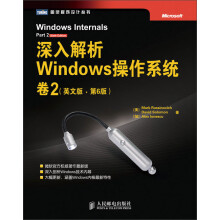深入解析Windows操作系统.卷2(英文版·第6版)

目 录内容简介
Windows Internals, Sixth Edition, Part
(See appendix for Part 1's table of contents)Chapter 8 I/O System
I/O System Components
The I/O Manager
Typical I/O Processing
Device Drivers
Types of Device Drivers
Structure of a Driver
Driver Objects and Device Objects
Opening Devices
I/O Processing
Types of I/O
I/O Request to a Single-Layered Driver
I/O Requests to Layered Drivers
I/O Cancellation
I/O Completion Ports
I/O Prioritization
Container Notifications
Driver Verifier
Kernel-Mode Driver Framework (KMDF)
Structure and Operation of a KMDF Driver
KMDF Data Model
KMDF I/O Model
User-Mode Driver Framework (UMDF)
The Plug and Play (PnP) Manager
Level of Plug and Play Support
Driver Support for Plug and Play
Driver Loading, Initialization, and Installation
Driver Installation
The Power Manager
Power Manager Operation
Driver Power Operation
Driver and Application Control of Device Power
Power Availability Requests
Processor Power Management (PPM)
ConclusionChapter 9 Storage Management
Storage Terminology
Disk Devices
Rotating Magnetic Disks
Solid State Disks
Disk Drivers
Winload
Disk Class, Port, and Miniport Drivers
Disk Device Objects
Partition Manager
Volume Management
Basic Disks
Dynamic Disks
Multipartition Volume Management
The Volume Namespace
Volume I/O Operations
Virtual Disk Service
Virtual Hard Disk Support
Attaching VHDs
Nested File Systems
BitLocker Drive Encryption
Encryption Keys
Trusted Platform Module (TPM)
BitLocker Boot Process
BitLocker Key Recovery
Full-Volume Encryption Driver
BitLocker Management
BitLocker To Go
Volume Shadow Copy Service
Shadow Copies
VSS Architecture
VSS Operation
Uses in Windows
ConclusionChapter 10 Memory Management
Introduction to the Memory Manager
Memory Manager Components
Internal Synchronization
Examining Memory Usage
Services Provided by the Memory Manager
Large and Small Pages
Reserving and Committing Pages
Commit Limit
Locking Memory
Allocation Granularity
Shared Memory and Mapped Files
Protecting Memory
No Execute Page Protection
Copy-on-Write
Address Windowing Extensions
Kernel-Mode Heaps (System Memory Pools)
Pool Sizes
Monitoring Pool Usage
Look-Aside Lists
Heap Manager
Types of Heaps
Heap Manager Structure
Heap Synchronization
The Low Fragmentation Heap
Heap Security Features
Heap Debugging Features
Pageheap
Fault Tolerant Heap
Virtual Address Space Layouts
x86 Address Space Layouts
x86 System Address Space Layout
x86 Session Space
System Page Table Entries
64-Bit Address Space Layouts
x64 Virtual Addressing Limitations
Dynamic System Virtual Address Space Management
System Virtual Address Space Quotas
User Address Space Layout
Address Translation
x86 Virtual Address Translation
Translation Look-Aside Buffer
Physical Address Extension (PAE)
x64 Virtual Address Translation
IA64 Virtual Address Translation
Page Fault Handling
Invalid PTEs
Prototype PTEs
In-Paging I/O
Collided Page Faults
Clustered Page Faults
Page Files
Commit Charge and the System Commit Limit
Commit Charge and Page File Size
Stacks
User Stacks
Kernel Stacks
DPC Stack
Virtual Address Descriptors
Process VADs
Rotate VADs
NUMA
Section Objects
Driver Verifier
Page Frame Number Database
Page List Dynamics
Page Priority
Modified Page Writer
PFN Data Structures
Physical Memory Limits
Windows Client Memory Limits
Working Sets
Demand Paging
Logical Prefetcher
Placement Policy
Working Set Management
Balance Set Manager and Swapper
System Working Sets
Memory Notification Events
Proactive Memory Management (Superfetch)
Components
Tracing and Logging
Scenarios
Page Priority and Rebalancing
Robust Performance
ReadyBoost
ReadyDrive
Unified Caching
Process Reflection
ConclusionChapter 11 Cache Manager
Key Features of the Cache Manager
Single, Centralized System Cache
The Memory Manager
Cache Coherency
Virtual Block Caching
Stream-Based Caching
Recoverable File System Support
Cache Virtual Memory Management
Cache Size
Cache Virtual Size
Cache Working Set Size
Cache Physical Size
Cache Data Structures
Systemwide Cache Data Structures
Per-File Cache Data Structures
File System Interfaces
Copying to and from the Cache
Caching with the Mapping and Pinning Interfaces
Caching with the Direct Memory Access Interfaces
Fast I/O
Read-Ahead and Write-Behind
Intelligent Read-Ahead
Write-Back Caching and Lazy Writing
Write Throttling
System Threads
ConclusionChapter 12 File Systems
Windows File System Formats
CDFS
UDF
FAT12, FAT16, and FAT32
exFAT
NTFS
File System Driver Architecture
Local FSDs
Remote FSDs
File System Operation
File System Filter Drivers
Troubleshooting File System Problems
Process Monitor Basic vs Advanced Modes
Process Monitor Troubleshooting Techniques
Common Log File System
NTFS Design Goals and Features
High-End File System Requirements
Advanced Features of NTFS
NTFS File System Driver
NTFS On-Disk Structure
Volumes
Clusters
Master File Table
File Record Numbers
File Records
File Names
Resident and Nonresident Attributes
Data Compression and Sparse Files
The Change Journal File
Indexing
Object IDs
Quota Tracking
Consolidated Security
Reparse Points
Transaction Support
NTFS Recovery Support
Design
Metadata Logging
Recovery
NTFS Bad-Cluster Recovery
Self-Healing
Encrypting File System Security
Encrypting a File for the First Time
The Decryption Process
Backing Up Encrypted Files
Copying Encrypted Files
ConclusionChapter 13 Startup and Shutdown
Boot Process
BIOS Preboot
The BIOS Boot Sector and Bootmgr
The UEFI Boot Process
Booting from iSCSI
Initializing the Kernel and Executive Subsystems
Smss, Csrss, and Wininit
ReadyBoot
Images That Start Automatically
Troubleshooting Boot and Startup Problems
Last Known Good
Safe Mode
Windows Recovery Environment (WinRE)
Solving Common Boot Problems
Shutdown
ConclusionChapter 14 Crash Dump Analysis
Why Does Windows Crash?
The Blue Screen
Causes of Windows Crashes
Troubleshooting Crashes
Crash Dump Files
Crash Dump Generation
Windows Error Reporting
Online Crash Analysis
Basic Crash Dump Analysis
Notmyfault
Basic Crash Dump Analysis
Verbose Analysis
Using Crash Troubleshooting Tools
Buffer Overruns, Memory Corruption, and Special Pool
Code Overwrite and System Code Write Protection
Advanced Crash Dump Analysis
Stack Trashes
Hung or Unresponsive Systems
When There Is No Crash Dump
Analysis of Common Stop Codes
0xD1 - DRIVER_IRQL_NOT_LESS_OR_EQUAL
0x8E - KERNEL_MODE_EXCEPTION_NOT_HANDLED
0x7F - UNEXPECTED_KERNEL_MODE_TRAP
0xC5 - DRIVER_CORRUPTED_EXPOOL
Hardware Malfunctions
ConclusionAppendix: Contents of Windows Internals, Sixth Edition, Part 1Index
(See appendix for Part 1's table of contents)Chapter 8 I/O System
I/O System Components
The I/O Manager
Typical I/O Processing
Device Drivers
Types of Device Drivers
Structure of a Driver
Driver Objects and Device Objects
Opening Devices
I/O Processing
Types of I/O
I/O Request to a Single-Layered Driver
I/O Requests to Layered Drivers
I/O Cancellation
I/O Completion Ports
I/O Prioritization
Container Notifications
Driver Verifier
Kernel-Mode Driver Framework (KMDF)
Structure and Operation of a KMDF Driver
KMDF Data Model
KMDF I/O Model
User-Mode Driver Framework (UMDF)
The Plug and Play (PnP) Manager
Level of Plug and Play Support
Driver Support for Plug and Play
Driver Loading, Initialization, and Installation
Driver Installation
The Power Manager
Power Manager Operation
Driver Power Operation
Driver and Application Control of Device Power
Power Availability Requests
Processor Power Management (PPM)
ConclusionChapter 9 Storage Management
Storage Terminology
Disk Devices
Rotating Magnetic Disks
Solid State Disks
Disk Drivers
Winload
Disk Class, Port, and Miniport Drivers
Disk Device Objects
Partition Manager
Volume Management
Basic Disks
Dynamic Disks
Multipartition Volume Management
The Volume Namespace
Volume I/O Operations
Virtual Disk Service
Virtual Hard Disk Support
Attaching VHDs
Nested File Systems
BitLocker Drive Encryption
Encryption Keys
Trusted Platform Module (TPM)
BitLocker Boot Process
BitLocker Key Recovery
Full-Volume Encryption Driver
BitLocker Management
BitLocker To Go
Volume Shadow Copy Service
Shadow Copies
VSS Architecture
VSS Operation
Uses in Windows
ConclusionChapter 10 Memory Management
Introduction to the Memory Manager
Memory Manager Components
Internal Synchronization
Examining Memory Usage
Services Provided by the Memory Manager
Large and Small Pages
Reserving and Committing Pages
Commit Limit
Locking Memory
Allocation Granularity
Shared Memory and Mapped Files
Protecting Memory
No Execute Page Protection
Copy-on-Write
Address Windowing Extensions
Kernel-Mode Heaps (System Memory Pools)
Pool Sizes
Monitoring Pool Usage
Look-Aside Lists
Heap Manager
Types of Heaps
Heap Manager Structure
Heap Synchronization
The Low Fragmentation Heap
Heap Security Features
Heap Debugging Features
Pageheap
Fault Tolerant Heap
Virtual Address Space Layouts
x86 Address Space Layouts
x86 System Address Space Layout
x86 Session Space
System Page Table Entries
64-Bit Address Space Layouts
x64 Virtual Addressing Limitations
Dynamic System Virtual Address Space Management
System Virtual Address Space Quotas
User Address Space Layout
Address Translation
x86 Virtual Address Translation
Translation Look-Aside Buffer
Physical Address Extension (PAE)
x64 Virtual Address Translation
IA64 Virtual Address Translation
Page Fault Handling
Invalid PTEs
Prototype PTEs
In-Paging I/O
Collided Page Faults
Clustered Page Faults
Page Files
Commit Charge and the System Commit Limit
Commit Charge and Page File Size
Stacks
User Stacks
Kernel Stacks
DPC Stack
Virtual Address Descriptors
Process VADs
Rotate VADs
NUMA
Section Objects
Driver Verifier
Page Frame Number Database
Page List Dynamics
Page Priority
Modified Page Writer
PFN Data Structures
Physical Memory Limits
Windows Client Memory Limits
Working Sets
Demand Paging
Logical Prefetcher
Placement Policy
Working Set Management
Balance Set Manager and Swapper
System Working Sets
Memory Notification Events
Proactive Memory Management (Superfetch)
Components
Tracing and Logging
Scenarios
Page Priority and Rebalancing
Robust Performance
ReadyBoost
ReadyDrive
Unified Caching
Process Reflection
ConclusionChapter 11 Cache Manager
Key Features of the Cache Manager
Single, Centralized System Cache
The Memory Manager
Cache Coherency
Virtual Block Caching
Stream-Based Caching
Recoverable File System Support
Cache Virtual Memory Management
Cache Size
Cache Virtual Size
Cache Working Set Size
Cache Physical Size
Cache Data Structures
Systemwide Cache Data Structures
Per-File Cache Data Structures
File System Interfaces
Copying to and from the Cache
Caching with the Mapping and Pinning Interfaces
Caching with the Direct Memory Access Interfaces
Fast I/O
Read-Ahead and Write-Behind
Intelligent Read-Ahead
Write-Back Caching and Lazy Writing
Write Throttling
System Threads
ConclusionChapter 12 File Systems
Windows File System Formats
CDFS
UDF
FAT12, FAT16, and FAT32
exFAT
NTFS
File System Driver Architecture
Local FSDs
Remote FSDs
File System Operation
File System Filter Drivers
Troubleshooting File System Problems
Process Monitor Basic vs Advanced Modes
Process Monitor Troubleshooting Techniques
Common Log File System
NTFS Design Goals and Features
High-End File System Requirements
Advanced Features of NTFS
NTFS File System Driver
NTFS On-Disk Structure
Volumes
Clusters
Master File Table
File Record Numbers
File Records
File Names
Resident and Nonresident Attributes
Data Compression and Sparse Files
The Change Journal File
Indexing
Object IDs
Quota Tracking
Consolidated Security
Reparse Points
Transaction Support
NTFS Recovery Support
Design
Metadata Logging
Recovery
NTFS Bad-Cluster Recovery
Self-Healing
Encrypting File System Security
Encrypting a File for the First Time
The Decryption Process
Backing Up Encrypted Files
Copying Encrypted Files
ConclusionChapter 13 Startup and Shutdown
Boot Process
BIOS Preboot
The BIOS Boot Sector and Bootmgr
The UEFI Boot Process
Booting from iSCSI
Initializing the Kernel and Executive Subsystems
Smss, Csrss, and Wininit
ReadyBoot
Images That Start Automatically
Troubleshooting Boot and Startup Problems
Last Known Good
Safe Mode
Windows Recovery Environment (WinRE)
Solving Common Boot Problems
Shutdown
ConclusionChapter 14 Crash Dump Analysis
Why Does Windows Crash?
The Blue Screen
Causes of Windows Crashes
Troubleshooting Crashes
Crash Dump Files
Crash Dump Generation
Windows Error Reporting
Online Crash Analysis
Basic Crash Dump Analysis
Notmyfault
Basic Crash Dump Analysis
Verbose Analysis
Using Crash Troubleshooting Tools
Buffer Overruns, Memory Corruption, and Special Pool
Code Overwrite and System Code Write Protection
Advanced Crash Dump Analysis
Stack Trashes
Hung or Unresponsive Systems
When There Is No Crash Dump
Analysis of Common Stop Codes
0xD1 - DRIVER_IRQL_NOT_LESS_OR_EQUAL
0x8E - KERNEL_MODE_EXCEPTION_NOT_HANDLED
0x7F - UNEXPECTED_KERNEL_MODE_TRAP
0xC5 - DRIVER_CORRUPTED_EXPOOL
Hardware Malfunctions
ConclusionAppendix: Contents of Windows Internals, Sixth Edition, Part 1Index
目 录内容简介
《深入解析Windows操作系统,卷2(英文版·第6版)》是操作系统内核专家Russinovich等人的Windows操作系统原理的最新版著作,针对Windows 7和Windows Server 2008 R2进行了全面的更新,主要讲述Windows的底层关键机制、Windows的核心组件(包括进程/线程/作业,安全性,I/O系统,存储管理、内存管理、缓存管理、文件系统和网络),并分析了启动进程、关机进程以及缓存转储。书中提供了许多实例,读者可以借此更好地理解Windows的内部行为。
《深入解析Windows操作系统,卷2(英文版·第6版)》内容丰富,信息全面,适合众多Windows平台开发人员、系统管理员阅读。
《深入解析Windows操作系统,卷2(英文版·第6版)》内容丰富,信息全面,适合众多Windows平台开发人员、系统管理员阅读。
比价列表







 缺书网
缺书网 扫码进群
扫码进群